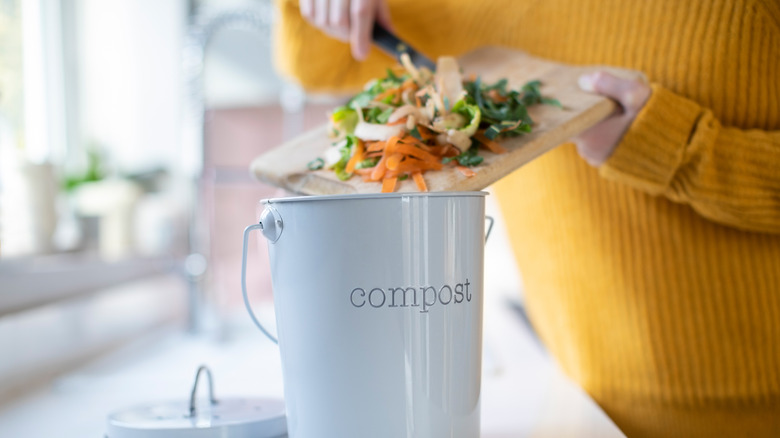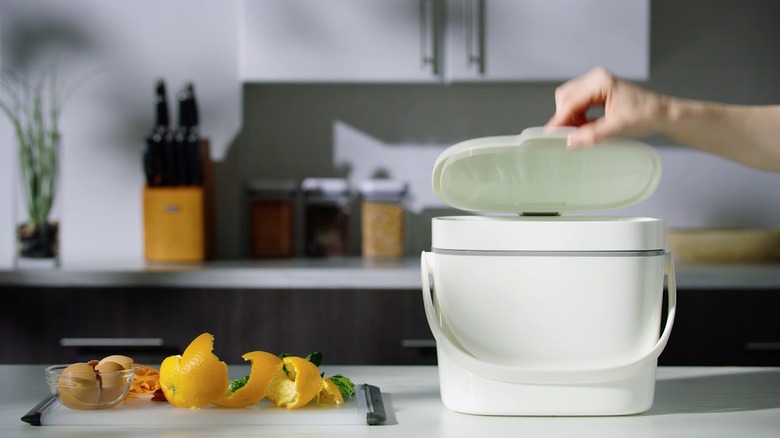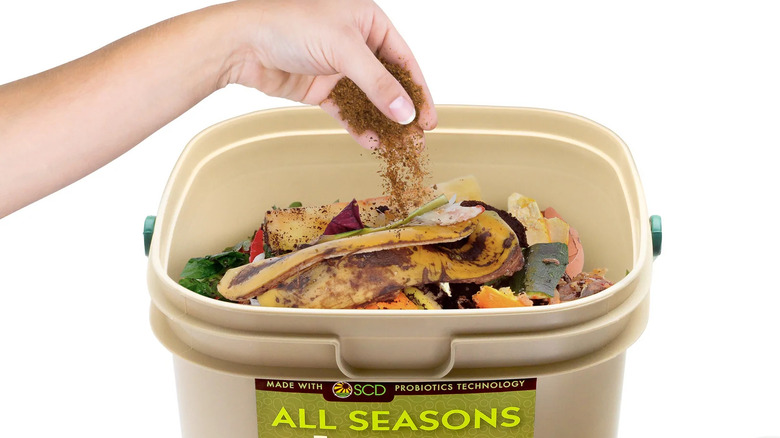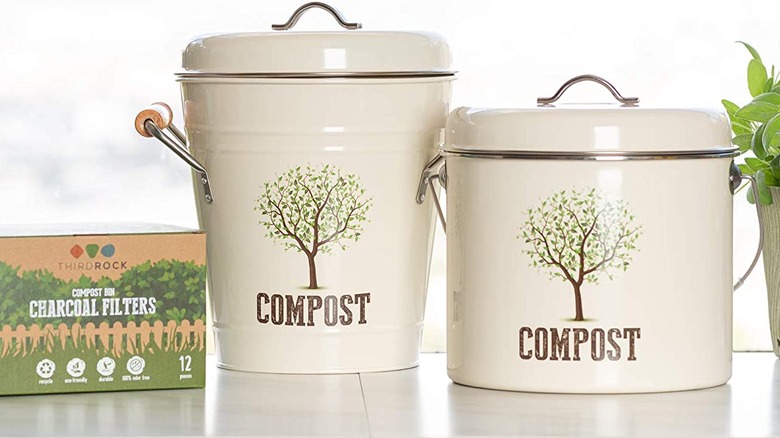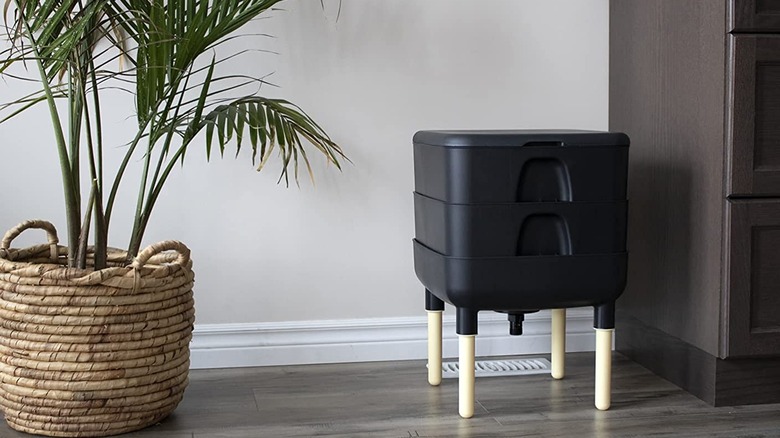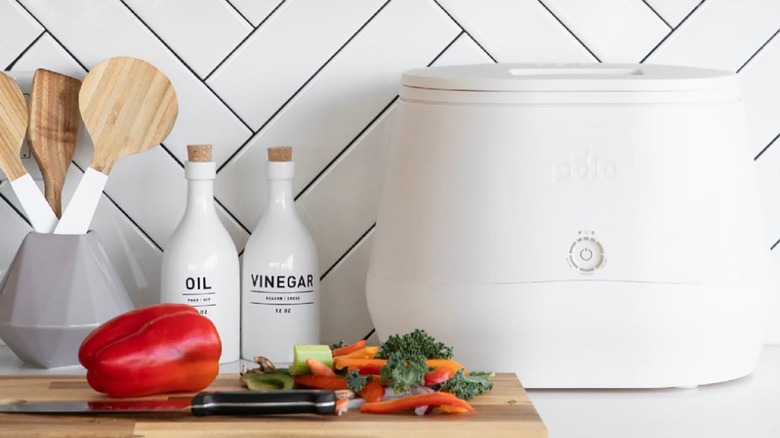The 5 Best Compost Bins You Need In Your Kitchen
We may receive a commission on purchases made from links.
One-quarter of Americans now define themselves as a foodie, a 5% increase since 2019. However, more time cooking can mean more waste generated by the kitchen, and wasting food is one of the biggest drivers of eco-guilt, according to the LA Times.
Composting at home is a common-sense solution that not only helps reduce food waste, and hopefully associated guilt, but turns this waste stream into productive material that can be used to grow more food or flowers. Unfortunately, composting food scraps can be a smelly and dirty endeavor, not to mention that many people don't have access to the recommended 3 to 5 cubic feet of space and organic material a classic compost pile needs to get going (via Maryland.gov).
Luckily there are plenty of innovative solutions to this set of issues. Modern indoor compost bins blend easily into your kitchen and are designed with various mechanisms to make reducing your food waste a cinch. Here are some of the best compost bins for your kitchen.
Best classic indoor composting bin
OXO is a company that was built by designing simple homeware products that work for almost everyone. Fast Company called the launch of their vegetable peeler "One of the most important moments in the history of industrial design". The same care and attention to detail have been brought to bear on the OXO Good Grips Easy-Clean Compost Bin. According to Serious Eats, the bin is dishwasher safe for effortless cleaning and is ergonomic enough to be opened and shut easily, even if you can't use your hands because they are covered in food.
The bin has a 1.75-gallon capacity, which means you won't need to empty it after every meal, but with a footprint of just 7.75 inches by 7.3 inches, it's still small enough to fit in almost any kitchen. The unique lid design hides the bag for a sleek look, stays open while you're working for easy use, reduces odors, and repels pests by keeping an adequate and continuous oxygen flow. Moreover, is one of the best-selling kitchen compost bins on Amazon, with almost 14,500 5-star ratings.
Best bin for bokashi composting
Bokashi composting is a quick-compost method that relies on sprays or sprinkles to inoculate the compost bin with microbes, which ferment and pickle the waste, according to Compost Collective. This means that you can use the bin to dispose of a lot more kitchen scraps than traditional composting methods, and it will produce usable products for your home and garden in a few weeks' time. Large bones, paper, plastic, and liquids should still all be avoided, but eggshells, cheese, coffee grounds, cooked and uncooked meat, and fish can all be fermented using Bokashi.
The Bokashi process has two phases, as The Compost Gardener explained. The first phase happens in the bin, where food scraps get layered with microbes, every 6cm or so. The microbes produce compost tea from the spigot at the bottom on an almost ongoing basis. Once filled, it ferments somewhere dark for 10 to 14 days, before phase two — the scraps get buried deep in the soil, to allow the acidity to neutralize. After 3-4 weeks the soil will be perfect for planting.
The SCD Probiotics Bokashi Starter Kit contains everything you need to start Bokashi composting on your kitchen countertop. The airtight lid keeps the process anaerobic and eliminates odor, the two-part bin drains the bokashi tea from the solid waste to keep the process going, and a tap allows for easy draining — the tea should be collected every few days and diluted before being used as plant food.
Best bin for compact composting
Composting is a habit as much as anything, and visual cues are an important tool for habit-building. Seeing an object that reminds you to start doing something is a great way to make a habit stick, according to James Clear, bestselling author of Atomic Habits. "If you want to make a habit a big part of your life, make the cue a big part of your environment." If composting is a habit you want to build, a cute compost bin that fits on your countertop and will stay odor-free is exactly the kind of visual cue to help you.
The classic and simple design of the Third Rock Kitchen Counter Compost Bin is an affordable, easy-to-clean option that, according to the reviews, is the perfect size for small apartments and kitchens with limited counter space. Available in 1.0 and 1.3-gallon sizes, the lid comes with an odor-canceling charcoal filter that will need replacing at your cost. Still, this extra line of defense gives peace of mind about having a metal box of vegetable scraps on the counter. As well as looking better than many plastic compost bins, the sturdy powder-coated steel construction will remain durable for many years of use.
Best bin for worm composting
An option that is more of an end-to-end composting solution, as well as a talking point for kids and guests, is vermiculture, or worm composting. Worms will convert most plant matter into worm castings that are excellent compost, according to the EPA.
Worried about the smell? You needn't be. Instead of letting food rot and get stinky, vermiculture is more like feeding pets — any food they enjoy eating won't be there long enough to smell. Feeding the worms involves digging a pit, burying scraps, and completely covering them again with dirt. The soil stops flies from reaching the scraps to lay any eggs. Per Wasteland Rebel, worms like it moist and dark, so most worm farmers cover their soil with at least a lid, if not a towel or newspaper, to keep the moisture in — meaning two or three layers of odor protection between the scraps and your nose. If your worm farm gets too wet, you can mix in some paper and cardboard, or drain excess liquid as worm tea fertilizer.
The FCMP Essential Living Composter is a worm composting solution that has been designed to slot into the modern home. It makes compost throughout the winter and helps new worm farmers control the moisture levels with both a drainage tap at the bottom and water channels at the sides to stop oversaturation or drying out at the edges.
Best bin for electric composting
Composting happens naturally. By making a compost pile, keeping a bin, or starting a worm farm, you actively encourage the processes you want. By building a big pile of compost and turning it regularly, outdoor compost generates a lot of heat, which speedily converts the waste into compost. Per the University of Illinois Extension, the pile ought to be between three feet cubed and five feet cubed for maximum efficiency.
This process still takes months though, and in areas where local wildlife, winter, or regulations make keeping a huge pile of edible matter outside of your house inconvenient or even dangerous, you may not have that kind of time. Enter electric compost bins, such as the Lomi Smart Waste Kitchen Composter. These units heat, chop and mix kitchen waste into usable soil in a similar amount of time as it takes to smoke a whole brisket, rather than as long as it takes to raise a whole cow.
These units are expensive, they use power, and some require extra pods and filters to make full use of them. However, if these drawbacks don't rule it out for you, smart composters can make a lot of sense.
